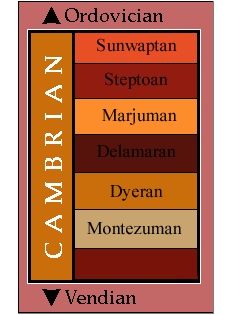







A lot can happen in 40 million years, the approximate length of the Cambrian period. Animals showed dramatic diversification during this period of Earth's history. This has been called the "Cambrian Explosion". When the fossil record is scrutinized closely, it turns out that the fastest growth in the number of major new animal groups took place during the Tommotian and Atdabanian stages of the Early Cambrian, a period of time which may have been as short as five million years! In that time, the first undoubdted fossil annelids, arthropods, brachiopods, echinoderms, molluscs, onychophorans, poriferans, and priapulids show up in rocks all over the world. Perhaps we should call this bit of time the "Tommotian Explosion".


Stratigraphic boundaries are determined by the occurences of fossils. For instance, the trace fossil Phycodes pedum marks the base of the Cambrian. This boundary is an unusual case, since stratigraphic boundaries are normally defined by the presence or absence of groups of fossils, called assemblages. In fact, much paleontological work is concerned with questions surrounding when and where stratigraphic boundaries should be defined. At first glance, this may not seem like important work, but consider this. If you wanted to know about the evolution of life on Earth, you would absolutely have to keep track of time. Questions such as: "how long did something stay the same?" or,"how fast did it change?" can only be assessed in the context of time.
Visit the homepage of the International Subcommittee on Cambrian Stratigraphy.
Find out more about the Cambrian paleontology and geology of North America at the Paleontology Portal.


